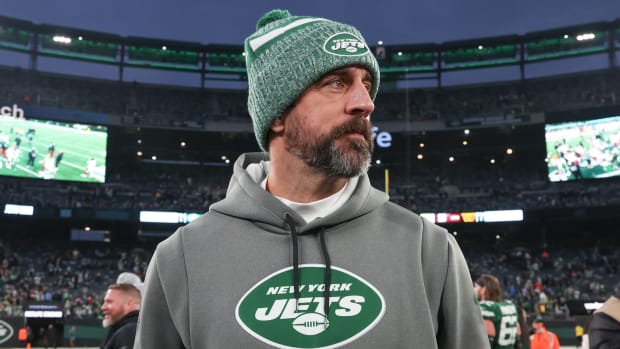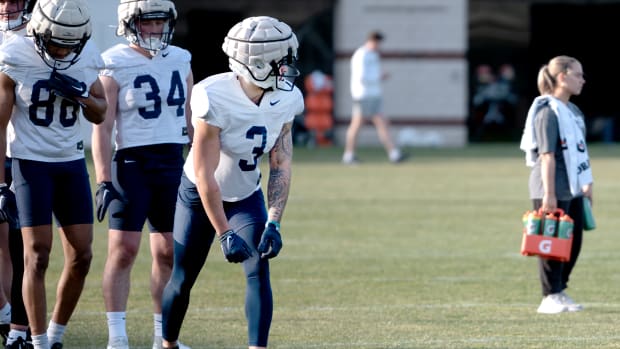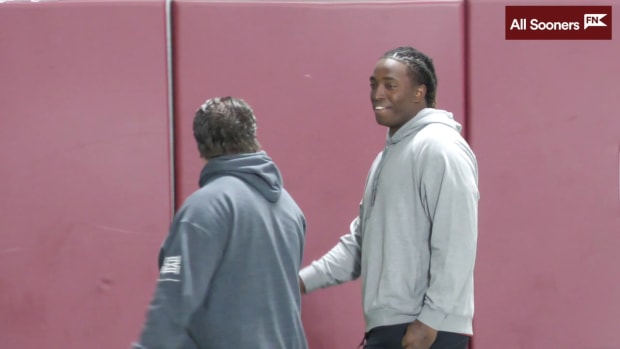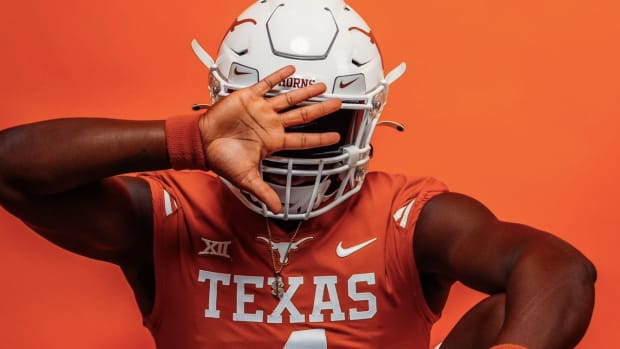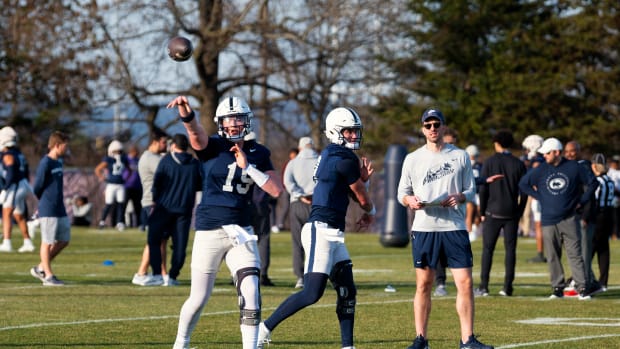At 9 a.m. on what would be an unprecedented day in college football’s baroque, bewildering and bellicose history, a text dropped in from a TV executive who was watching the tumult unfold:
“It’s athletic directors, coaches and players vs. presidents, trustees and lawyers in the most intriguing battle in NCAA history.”
It was the perfect summation of the underlying tension of this Summer of COVID-19.
At that point, nobody was sure who was going to win that epic confrontation. By the end of the day, it was a split decision. Presidents, trustees and lawyers scored two early victories in the Big Ten and Pac-12; athletic directors, coaches and players got an apparent late win in the Big 12.
The first two leagues formally canceled fall sports, which means for the first time in the 124-year history of the Big Ten and 61-year history of Pac-12, no school in either league will play football. There were Big Ten football champions during World War I, the depths of the Depression and World War II. But there won’t be in 2020.
The Big 12, meanwhile, emerged from a league call Tuesday night saying that it will continue on a path toward playing in the fall. It was a less-than-total declaration, with one league source telling colleague Ross Dellenger: “This doesn’t mean we’re going to play. Students are coming back to campus.”
BARNHART: If ACC, Big 12 Also Bail, Would SEC Go It Alone?
Still, this was big news—and not just for those 10 Big 12 teams and their fans. It was a necessary threshold to reach for the Atlantic Coast and Southeastern conferences as well. If what had been described by sources as a “split” Big 12 stays the course, it means that a majority of the Power 5 is going forward—which was the assurance the ACC needed to stay in the fold.
So it is increasingly likely that college football will happen in the fall—diminished and divided though it will be. This is how it works for the oligarchy that runs the sport. There are alliances at times, but no true solidarity and no central leadership. The prevailing ethos: every rich league for itself. (And in this instance, find a few cardiologists who align their thoughts on COVID-19-related heart issues with what your league wants to do.)
But for those pressing forward to play, heed one warning: The lawyers will be circling. Not the ones counseling conferences to avoid trifling with players’ health, but the ones who will be doing the suing if, God forbid, a player dies, has long-term damage or career-threatening complications. In an email to Sports Illustrated, prominent college sports attorney Tom Mars offered this chilling view of what the Big 12, ACC and SEC could be getting into:
“Whatever conference(s) decides to play football this fall will be taking a ridiculously high risk they may soon regret. I know and have talked with some of the best plaintiff’s lawyers in the country this week, and they’re praying the SEC, Big 12 and/or the ACC are greedy enough to stay the course. If things go sideways, the plaintiff’s Bar will immediately get their hands on the internal financial analyses of the schools (a FOIA layup), get the conference financials through the discovery process, and then just stand in front of the jurors and point to the conferences that decided not to risk the health of their student-athletes. Good Lord, I’d hate to be the lawyers defending those cases.”
And the attorneys lining up to represent plaintiffs? “These are lawyers who’ve already slain bigger dragons than the SEC, and they can afford to finance the most expensive litigation on the planet. As a coalition, they’d be the legal equivalent of the Death Star.”
Sleep well, Big 12, ACC and SEC leaders.
Obviously, the fervent wish is for those who do play to suffer no ill effects. For those who don’t play, there is ample empathy.
It’s heartbreaking for all the Big Ten and Pac-12 athletes, in all the fall sports. It’s brutal for all the thousands of people whose jobs revolve around fall Saturdays in college towns like Ann Arbor and Champaign and Corvallis and Pullman. It’s a sad day for all of us who love college football.
It also could have been avoided, if the U.S. hadn’t blown off its collective responsibility to combat the COVID-19 scourge for much of the summer. The responsibility for that failure starts at the feckless, reckless top, but doesn’t end there. Before we get mad at our local university president or regional conference commissioner for taking away football, we should all grade our own virus film, to use a football term.
DELLENGER: Big 12 Keeps Hope of Fall Season Alive—for Now
Currently, the score in the most intriguing battle in NCAA history is 2–0 in favor of those who have something bigger to worry about than whether their team wins on fall Saturdays. But back to the skirmish results from Tuesday: The university presidents, who are tasked with thinking about the greater good of an entire campus, did something they rarely do—they said no to big-time athletics. Did they want to? Of course not. It’s unpopular, and it exposes their athletic departments to massive financial hardship. But they made the hard, proper call in the midst of a pandemic that remains difficult to understand and harder to predict.
“There is simply too much unknown risk for us to proceed with the confidence we need to launch our sports seasons,” said Wisconsin AD Barry Alvarez.
These decisions were made under considerable pressure, during a rare public showdown between the academic heads of major universities and their more famous (and often more popular) athletic subordinates. Sports fans are loud enough, but the noise in the system at the conference and university leadership level went up several decibels when the players themselves cranked up hashtag movements on social media, and then famous coaches chimed in, and then here came the politicians. When the president and vice president of the United States are both lobbying to play ball, that has to be considered.
The folks in athletics did their part to move the goalposts. Penn State coach James Franklin, in May: “I'm a believer in science. I'm a believer in medicine and listening to the experts.” James Franklin on Twitter this week, when it looked like the Big Ten’s scientists and doctors and experts were favoring postponement: “I love our players & believe it is my responsibility to help them chase their dreams, both collectively & individually. I am willing to fight WITH them & for our program!”
What had been a swift Big Ten progression toward a decision was slowed in the final hours. What had been considered a formality took on a tinge of drama. Would the league really tell a grandstanding Ryan Day, an angry Jim Harbaugh and a forceful Franklin to hang up their whistles until spring?
Yes it would, as led by a rookie commissioner. Kevin Warren, leading the Big Ten, stood in what looked like a collapsing pocket and delivered an accurate (if unpopular) decision. "This is a very, very trying time,” he said Tuesday. “It’s one of those days you hope in your career you don't have to deal with. But that's not the case in life—we have to deal with what's in front of us.”
For so long throughout this staggering journey toward kickoff, college football’s leadership has been embarrassingly weak. The NCAA and president Mark Emmert are virtually absent. Conferences have been fickle and slow, waiting for someone else to lead. It’s gotten so bad that one FBS athletic director stood in front of his football team Monday and apologized for the terrible leadership in college sports. “You deserve better,” he told them.
The collateral damage during all this dithering has been the athletes themselves, left twisting for weeks while trying to maintain focus on workouts for a season that may not arrive. Now that decisions are being made, universities owe them rapid answers on two fronts:
- If your team is playing, what will the testing protocols and other safeguards be throughout the season?
- If your team is not playing, what will the school do to support you in terms of scholarship, eligibility, access to facilities and mental health?
The split in college football is a microcosm of the split in our society, and much of it falls along the same lines. As a colleague said, a Venn diagram of those angry about canceled football seasons and those angry about wearing masks might be one circle. It’s exhausting—and also not over.
The SEC, ACC and Big 12, along with, potentially, the American Athletic, Conference USA and Sun Belt, still have to get to kickoff. There likely are many more skirmishes ahead in the battle of athletic directors, coaches and players vs. presidents, trustees and lawyers.
Read more of SI's Daily Covers stories here
More From NCAA Coverage From SI.com Sites:
Ohio State Players' Twitter Reaction to Big Ten's Decision
ASU's Herm Edwards Talks Pac-12 Football Cancellation
Iowa's Ferentz Delivers the News on the Loss of a Season
January Football Games Are Nothing New to UW—Just Husky Stadium
What Would a Spring College Football Season Look Like?



